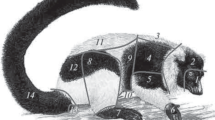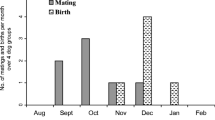Abstract
Grooming interactions (n=83) occurring in a group of non free-ranging adult neutered male (n=14) and female (n=11) domestic cats (Felis silvestris catus) were analysed. Grooming was not induced by the proximity (distance <=0.5 m) of another animal. Grooming was in general directed at the head-neck area. Higher ranking animals groomed lower ranking animals more often than the other way round. Groomers tended to adopt ‘higher’ (standing, sitting upright) postures than groomees (sitting, lying). Agonistic behaviour occurred in 35% of interactions. Groomers showed offensive behaviour more often than groomees, most often after grooming a partner. Furthermore groomers often groomed themselves after grooming a partner. The degree of relatedness of animals did not affect the frequencies or durations of grooming. These results are consistent with the hypothesis that allogrooming in domestic cats may be a way of redirecting (potential) aggression in situations in which overt aggression is too costly.
Similar content being viewed by others
References
Aureli, F. & C.P. van Schaik 1991 Post-conflict behaviour in long-tailed macaques (Macaca fascicularis): II. coping with the uncertainty.Ethology 89: 101–114.
Boccia, M. L., M. Reite & M. Laudenslager 1989 On the physiology of grooming in a pigtail macaque.Physiol. Behav. 45: 667–670.
Bos, van den R. 1995a Enige inzichten in het sociale gedrag van katten.Biotechniek 34: 27–31.
Bos, van den R. 1995b Recent insights in cat social behaviour.ANZCCART News 8(4): 5–6.
Bos, van den R. 1996 Post conflict behaviour in domestic cats in confinement, Proceedings of International Society for Anthrozoology Meeting in Cambridge, UK, 24–26th July 1996, p.65.
Bos, van den R. & Tj. de Cock Buning 1994a Social behaviour of domestic cats (Felis lybica forma catus L.): A study of dominance in a group of female laboratory cats.Ethology 98: 14–37.
Bos, van den R. & Tj. de Cock Buning 1994b Social and non-social behaviour of domestic cats (Felis catus L.): a review of literature and experimental findings. In: (Bunyan, J (ed.)Welfare and Science Royal Society of Medicine Press London pp.53–57.
Bos, van den R & H. de Vries 1996 Clusters in social behaviour of female domestic cats (Felis silvestris catus) living in confinement.J. Ethol. 14: 123–131.
Bradshaw, J.W.S. 1992 The Behaviour of the Domestic Cat. C.A.B. International, Wallingford, U.K.
Bradshaw, J.W. & S.L. Brown 1992 Social behaviour of cats. Tijdschrift voor Diergeneeskunde vol 117 Suppl. 1, pp.54S-56S.
Brown, S.L. 1993 The Social Behaviour of Neutered Domestic Cats (Felis catus), PhD Thesis University of Southampton. Southampton, U.K.
Feh, C. & de J. Mazieres 1993 Grooming at a preferred site reduces heart rate in horses.Anim. Behav. 46: 1191–1194.
Goosen, C. 1980 On grooming in Old World monkeys, PhD Thesis University of Leiden, Leiden, the Netherlands.
Grant, E.C. 1963 The analysis of the social behaviour of the male laboratory rat.Behaviour 21: 260–281.
Harrison, C.J.O. 1964 Allopreening as agonistic behaviour.Behaviour 24: 161–209.
Hart, B.L. & L.A. Hart 1992 Reciprocal allogrooming in impala,Aepyceros melampus.Anim. Behav. 44: 1073–1083.
Hemelrijk, C.K. 1990 Models of, and tests for, reciprocity, unidirectionality and other social interaction patterns at a group level.Anim. Behav. 39: 1013–1029.
Hemelrijk, C.K. & A. Ek 1991 Reciprocity and interchange of grooming and ‘support’ in captive chimpanzees.Anim. Behav. 41: 923–935.
Hooff, van J.A.R.A.M. & J.A.B. Wensing 1987 Dominance and its behavioral measures in a captive wolf pack, In:Man and Wolf (Frank, H. ed.) Junk Publishers, Dordrecht pp.219–252.
Kappeler, P. & C.P. van Schaik 1992 Methodological and evolutionary aspects of reconciliation among primates.Ethology 92: 51–69.
Krebs, J.R. & N.B. Davies 1993 An introduction to Behavioural Ecology, 3rd edition Blackwell Scientific Publications, Oxford.
Leyhausen, P. 1979 Cat Behavior; The Predatory and Social Behavior of Domestic and Wild Cats. Garland STPM Press, New York and London.
Liberg, O. & M. Sandell, 1988 Spatial organization and reproductive tactics in the domestic cats and other felids. In: The Domestic Cat: the Biology of its Behaviour. (Turner, D.C. & Bateson, P., eds.) Cambridge University Press, Cambridge, pp. 83–98.
Macdonald, D.W., P.J. Apps, G.M. Carr & G. Kerby 1987 Social dynamics, nursing coalitions and infanticide among farm cats,Felis catus.Adv. Ethology 28: 1–66.
Maestripieri, D., G. Schino, F. Aureli & A. Troisi 1992 A modest proposal: displacement activities as an indicator of emotions in primates.Anim. Behav. 44: 967–979.
Mooring, M.S. & B.L. Hart 1993 Effects of relatedness, dominance, age and association on reciprocal allogrooming by captive impala.Ethology 94: 207–220.
Natoli, E. & E. de Vito 1991 Agonistic behaviour, dominance rank and copulatory success in a large multi-male feral cat,Felis catus L., colony in central Rome.Anim. Behav. 42: 227–241.
O’Brien, T.G. 1993 Allogrooming behaviour among adult female wedge-capped capuchin monkeys.Anim. Behav. 46: 499–510.
Podberscek, A.L., J.K. Blackshaw & A.W. Beattie 1991 The behaviour of laboratory colony cats and their reactions to a familiar and unfamiliar person.Appl. Anim. Behav. Sci. 31: 119–130.
Seyfarth, R.M. 1976 Social relationships among adult female baboons.Anim. Behav. 24: 917–938.
Seyfarth, R.M. 1977 A model of social grooming among adult female monkeys.J. Theor. Biol. 65: 671–698.
Seyfarth, R.M. 1980 The distribution of grooming and related behaviours among adult female vervet monkeys.Anim. Behav. 28: 798–813.
Smith, D.F.E., K.J. Durman, D.B. Roy & J.W.S. Bradshaw 1994 Behavioural aspects of the welfare of rescued cats.J. Feline Advisory Bureau 31: 25–28.
Sokal, R.R. & F.J. Rohlf 1981 Biometry; The Principles and Practice of Statistics in Biological Research, 2nd edition, W.H. Freeman & Co., New York.
Spruijt, B.M., J.A.R.A.M. van Hooff & W.H. Gispen 1992 Ethology and neurobiology of grooming behavior.Physiol. Rev. 72: 825–852.
Terry, R.L. 1970 Primate grooming as a tension reduction mechanism.J. Psychol. 76: 129–136.
Troisi, A. & G. Schino 1986 Diurnal and climatic influences on allogrooming behaviour in a captive group of Java monkeys.Anim. Behav. 34: 1420–1426.
Troisi, A. & G. Schino 1987 Environmental and social influences on autogrooming behaviour in a captive group of Java monkeys.Behaviour 100: 292–302.
Troisi, A., G. Schino & F. Aureli 1989 Allogrooming and inter-individual proximity in two species of macaques (macaca fascicularis and m. nemestrina).Behaviour 111: 196–207.
UK Cat Behaviour Working Group 1991 An Ethogram for Behavioural Studies of the Domestic Cat (Felis catus L.), UFAW Animal Workshop Report No. 1, UFAW Potters Bar, U.K.
Willemse, T., M. Mudde, M. Josephy & B.M. Spruijt 1994 The effect of haloperidol and naloxone on excessive grooming behavior of cats.Eur. Neuropsychopharmacol. 4: 39–45.
Willemse, T. & B.M. Spruijt 1995 Preliminary evidence for dopaminergic involvement in stress-induced excessive grooming in cats,Neurosci. Res. Comm. 17: 203–208.
Wilson, E.O. 1975 Sociobiology: The New Synthesis. Harvard University Press, Cambridge Massachuttes
Author information
Authors and Affiliations
Additional information
The data were previously presented at the 29th International Congress of the International Society for Applied Ethology (van den Bos, R. (1995) Allogrooming in domestic cats in confinement, Proceedings of the 29th International Congress of the International Society for Applied Ethology, S.M. Rutter et al. (Eds.), pp. 109–110)
About this article
Cite this article
van den Bos, R. The function of allogrooming in domestic cats (Felis silvestris catus); a study in a group of cats living in confinement. J. Ethol. 16, 1–13 (1998). https://doi.org/10.1007/BF02896348
Received:
Accepted:
Issue Date:
DOI: https://doi.org/10.1007/BF02896348




